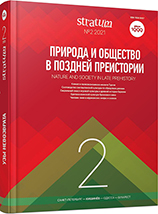Труд и питание горняков бронзового века Южного Зауралья (по данным изотопного состава стронция в остеологических остатках рудника Новотемирский)
Labor and food of Bronze Age miners in the Southern Trans-Urals (based on the strontium isotopic composition in the Novotemirsky mine osteological remains)
Author(s): Polina S. Ankusheva, Daria V. Kiseleva, Olga P. Bachura, Irina P. Alaeva, Maksim N. Ankushev, Tatiana G. OkunevaSubject(s): History, Archaeology
Published by: Издательский дом Stratum, Университет «Высшая антропологическая школа»
Keywords: Southern Trans-Urals; Late Bronze Age; copper metallurgy; ancient mine; strontium isotopes; osteology;Alakul culture;
Summary/Abstract: The article addresses organization of Late Bronze Age mining in the Southern Trans-Urals, in particular the degrees of its specialization and the scale of exchange operations. The main object is bone remains from the cultural layer of the II millennium BC of the Novotemirsky mine. The species and age composition of domestic animals are similar to the settlement materials of the Sintashta, Srubnaya-Alakul, and Sargary-Alekseevo settlements of the region. Comparison of 87Sr/86Sr variations in local bioavailable strontium baseline proxies and archaeological samples has indicated that the range of cattle grazing was located mainly within the immediate vicinity of the Novotemirsky mine. The results suggest that the mining organization model implemented at the Novotemirsky mine was similar to the Alakul culture of the Ural-Mugodzhary mining and metallurgical center and was characterized by the absence of specialized miner settlements, and the participation of the population of nearby villages in labor and meals organization at the mines, as well as by the poor development of trade and exchange operations.
Journal: Stratum plus. Археология и культурная антропология
- Issue Year: 2021
- Issue No: 2
- Page Range: 69-83
- Page Count: 15
- Language: Russian
- Content File-PDF

